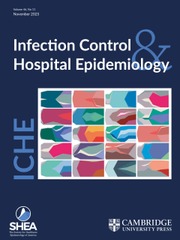To the Editor:
We read with interest the recent expansion of the National Healthcare Safety Network (NHSN) surveillance criteria to include non-culture-based testing (NCT), including plasma metagenomic next-generation sequencing (mNGS), in bloodstream infection (BSI) definitions. 1 While mNGS provides diagnostic utility in complex cases, Reference MacIntyre, Hirst, Duttagupta, Hollemon, Hong and Blauwkamp2 we have concerns about its integration into healthcare-associated infection (HAI) surveillance frameworks such as NHSN, where standardization, reproducibility, and clinical relevance are essential. 1
Under current guidelines, a positive plasma mNGS may fulfill NHSN’s laboratory-confirmed BSI (LCBI) criteria in the central line-associated bloodstream infection (CLABSI) definition if no blood cultures are collected within 2 days before, or 1 day after the NCT. 1 Although this policy is narrowly applied, its implications warrant critical examination given the methodological divergence of plasma mNGS from conventional diagnostics.
Plasma mNGS detects all circulating microbial cell-free deoxyribonucleic acid (cfDNA), regardless of organism viability or clinical relevance. Signals may derive from active infections, treated infections, mucosal translocation, sample contamination, or colonization of vascular devices through which the sample was collected. Reference Chiu and Miller3,Reference Gu, Miller and Chiu4 The assay lacks anatomical source attribution, or temporal linkage to clinical events, features that are central to NHSN’s surveillance definitions. For example, a positive plasma mNGS result may persist for days to weeks after clinical recovery or antimicrobial treatment, and its detection is influenced by factors such as disease burden, mucosal barrier integrity, host immune status, and the kinetics of cfDNA release, clearance, and cell turnover. Reference Babady5,Reference Eichenberger, de Vries and Ruffin6 These factors may complicate the attribution of infection to specific exposures or devices, a cornerstone of CLABSI classification.
Unlike conventional culture-based diagnostics, plasma mNGS platforms lack external proficiency testing, operate as laboratory-developed tests with proprietary bioinformatics pipelines, and differ in sequencing methods and laboratory workflows. Reference Gu, Miller and Chiu4,Reference Han, Diao and Lai7 There are no standardized interpretive thresholds. While Karius, the most widely used commercial plasma mNGS platform, reports quantitative results in molecules per microliter, the clinical significance of these values remains undefined. 8 When used for the purpose of benchmarking, surveillance requires consistency across institutions and plasma mNGS currently may not meet this requirement.
Some may argue that false positives exist with all diagnostic modalities and that NHSN definitions tolerate such limitations. Indeed, blood cultures also lack source localization, and commensal skin flora may yield positive cultures. However, culture-based definitions are anchored by conservative interpretive frameworks, requiring specific timing, thresholds, and organism exclusions. In contrast, mNGS captures any microbial cfDNA without distinction between commensal, colonizing, or pathogenic organisms. NHSN’s commensal list does not map cleanly to metagenomic taxonomy, complicating interpretation.
While the inclusion of positive plasma mNGS testing in the NHSN CLABSI definition may only modestly inflate HAI rates today, we are concerned that the groundwork is being laid for future inclusion of molecular assays without sufficient validation. The extent to which United States institutions utilize mNGS is variable and not actively being monitored. Anecdotally, some institutions report sending tests on a weekly basis with minimal stewardship oversight, while others restrict use to very few select cases following rigorous review. Reference Shean, Garrett, Malleis, Lieberman and Bradley9 Test indications are not always consistently restricted to diagnostically complex scenarios. Without validated interpretive frameworks and clear usage criteria, broader adoption may compromise the integrity of CLABSI attribution.
At one of the authors’ institutions, Karius testing is reserved for a small subset of highly immunocompromised patients (approximately 3 to 5 tests per year) to identify organisms that may inform changes to targeted antimicrobial therapy after conventional culture-based methods fail to yield results. In one case, a Karius test was sent for a patient with persistent symptoms and negative blood cultures. The result was positive for an organism that is rarely a human pathogen. The patient was already receiving antimicrobial therapy with presumed activity against the organism and no therapeutic changes were made. Nonetheless, the case met NHSN LCBI criteria due to the timing of the test and absence of blood culture collection within specific time windows. This example highlights a key flaw in the criteria, which is that these types of tests are often ordered late in the diagnostic course, after prolonged and exhaustive culture-based evaluation, yet their results may still meet surveillance definitions despite limited clinical relevance. To our knowledge, no large-scale studies have evaluated the impact of plasma mNGS testing on CLABSI attribution, underscoring the need for further evaluation before broader adoption into surveillance systems.
We acknowledge that conventional diagnostics are imperfect and that surveillance definitions must evolve alongside diagnostic technologies. However, responsible integration requires validation, transparency, and safeguards to preserve the core goals of HAI surveillance, which are essential to support quality improvement, enable benchmarking, and maintain institutional accountability. 10 The inclusion of assays that detect non-viable or clinically irrelevant microbial cfDNA signals may undermine clinician confidence in surveillance metrics and disincentivize engagement in infection prevention.
In conclusion, plasma mNGS lacks standardization, source attribution, and validated thresholds for use in HAI surveillance. We urge caution in its use for CLABSI attribution. Understanding test utilization patterns and their impact on surveillance metrics will be critical to inform future NHSN policy on integrating novel molecular diagnostics.
Acknowledgments
None.
Financial support
This work was supported by the National Center for Advancing Translational Sciences, National Institutes of Health (NIH), Award Number 1K12TR004384 (K.S.F.). The content is solely the responsibility of the authors and does not necessarily represent the official views of the NIH.
Competing interest
ZW serves on the advisory boards of Viracor and Anvil Diagnostics. All other authors have no conflict of interest relevant to this article.


